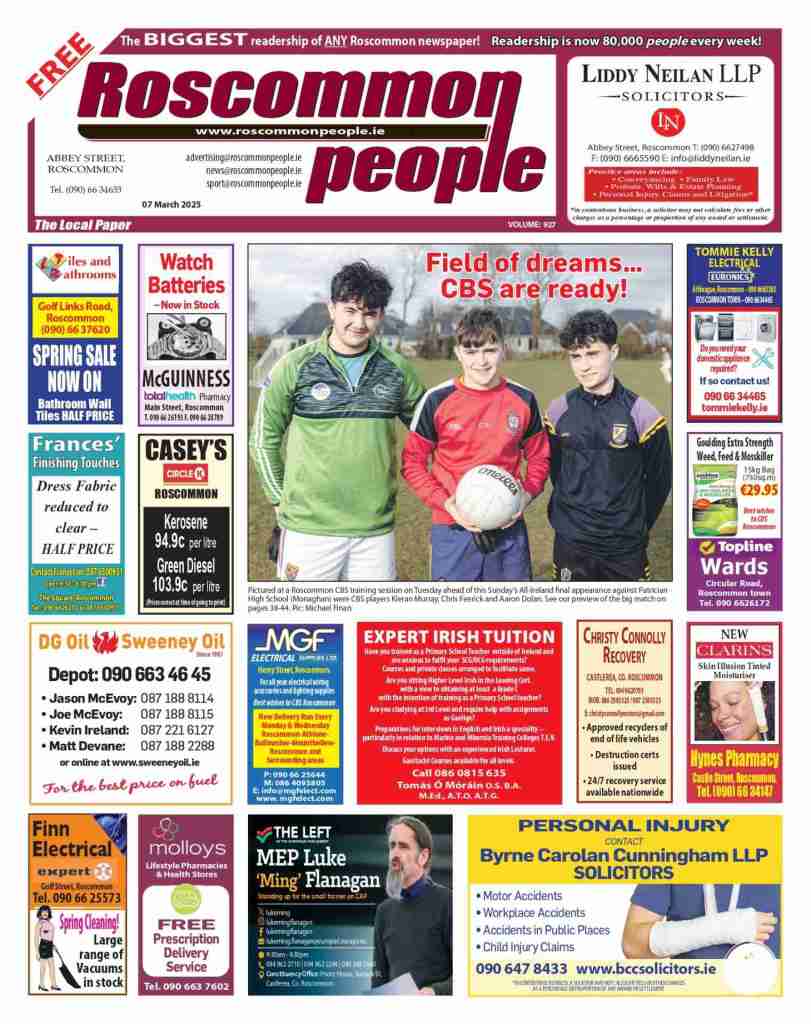It’s over 30 years since I first drove a car around the famous Ring of Kerry. It was quite a challenge for a young driver like me, one who was not accustomed to such twists and turns on what are narrow tracks – not to mention the never-ending distractions of the cliff edges and the vistas down below. It was a memorable experience.
For that very first summer visit to the Kingdom, my companions were four former classmates from the old ‘Tech’ in Lanesborough. I was test-driving a Mazda 626 for a motoring column I was writing in the Cavan Leader newspaper. We drove almost the entire length of the western seaboard that week – long before they paid somebody half a fortune to market it as the ‘Wild Atlantic Way’. I can confirm it was also very wild at that time (as were we) – and I’m not just talking about the landscapes. It was an exhaustive drive, and, apart from having to eject one Ballyleague man from the driver’s seat at one of the worst of the bends, we survived the experience.
This week I returned to Kerry with my own family for a somewhat more relaxed journey around the ring and a few other parts of the county. We drove to Dingle, Valentia Island, Derrynane, Kenmare, Sneem, Tralee and Killarney. The place was mobbed. Arriving at the marina in Dingle, I was a bit shocked to see such a heaving throng of people on the road – my first occasion to be within such a group since the Covid-19 lockdowns ended. To be truthful, it made you think twice before you even got out of the car to explore.
It was in Tralee when this whole vexed issue of tourism, how it’s promoted, and how the money is spent by those in authority at national level, came to mind once again. I know it’s an argument that has many supporters in the tourism business in our own part of the country, and I don’t mind saying that it’s something that annoys me greatly when I see the efforts being made by others to try and put their own little place on the map.
In case anybody thinks there’s a rant on the way about Kerry tourism, nothing could be further from the truth. I have been in Kerry enough times to see the scale of the investment business people there have put in over the last 50 years – and it’s quite incredible. A simple drive from the town centre in Killarney to the gates of Muckross House will provide evidence of the huge investment poured into this industry – new hotel after new hotel, guesthouse after guesthouse – all beautifully designed and all heaving with tourists in high summer. The Gleneagle Hotel, on its own, seems to have grown and expanded in ten different directions since the last time I was here, and I know for a fact that there were little or no government grants available to make this happen. The developers and the landowners had to go into the bank in Killarney and make a business case for their loans and extensions. They did their homework well because their investment is now being repaid in bucket-loads – even at the end of a most difficult year.
My quarrel is not with the industry in Kerry, but with the people who decide at national level where and when regional investment should be made in terms of developing new attractions and promoting new parts of the country where the tourists are not thronging in their thousands.
In Tralee, I couldn’t help but notice the success, for example, of the Blennerville Windmill tourism attraction – promoted extensively all over the place with signage (and online) as part of the Wild Atlantic Way – tagged as Ireland’s largest working windmill and Kerry’s model railway. It seems to me that thousands and thousands of euro have been invested by the tourism authorities at regional and national level – quite separate to the windmill management itself – and the result is a huge boost in tourism numbers for the windmill and the Tralee area.
The blurb for the Tralee site on its promotional material raised another eyebrow or two. It states: ‘Blennerville Windmill stands as the dominant landmark in Tralee Bay – where the town of Tralee meets the Dingle Peninsula. It was authentically restored to full working order in the 1980s. It is the only windmill along Ireland’s Atlantic Way and is the largest working windmill in Ireland’.
Three weeks ago I stood in Elphin and listened to Barry Beirne and the hard-working volunteers of the local windmill committee as they talked about their struggles to try and promote their windmill on the edge of the town. Built around 1730, this building is recognised as the oldest operational windmill in the country – even older than Blenerville. The restoration work done in the 1990s was absolutely spectacular and any visit to the top floor of the building will confirm the fantastic nature of the workmanship and unique design – in a building recognised as the only remaining working windmill of its kind in the west of Ireland today.
The local committee are doing their absolute best to promote the centre – and the mill was busy with callers on the day I visited – but the committee is still working in a voluntary capacity and are adamant that they should have a manager and staff there in the key tourism months to welcome visitors and show them around this majestic site.
With some good help from Roscommon LEADER Partnership, Roscommon County Council and other agencies in recent months, they are now on the way to building a new coffee shop, yet when you speak to the volunteers, you get the sense that they need support at national level to make this project really come to fruition and reach its true potential. They need the leg up that Blennerville already gets in Tralee in terms of promotion and marketing at national level – and they need it quickly.
Furthermore, the Elphin committee have what I consider to be one of the most basic of claims for fair treatment in another key area – they are seeking support in the payment of the annual insurance premium for the site. Like so many other tourism operators, they face a steep premium payment every year – yet they are a not-for-profit group and are working in a relatively low-key risk area when it comes to insurance. They must surely be entitled to support. An old friend of mine in tidy towns circles has long campaigned for the biggest insurance companies in Ireland (who are paid millions by public bodies to insure their buildings every year) to come together and support not-for-profit community groups with a one-for-all style policy discount scheme so that they can concentrate their own funds instead on maintenance and painting, etc. Maybe one of these days somebody will listen.
Apart from the fascinating elements of the visit to the windmill, I found something far more extraordinary across the road from the site when I visited recently. There is only one word to describe the new park that has now been developed there – and that word is UNIQUE.
It’s a real gem for visitors and locals – a new woodland park with up to 5,000 native trees, stone paths and trails, four ponds, multiple seats and resting places, over 500 pollinators, wild meadow flowers, tunnels for the kids and fruit trees, as well as a tarmacaded car park at the front. I think it’s actually something that is going to win national awards for its biodiversity and wildlife in years to come. Barry Beirne and the committee should really take a bow for the tremendous work they have already done here. Bloody hard work it was too, and there’s more of that to come.
This is why I believe that committees like the one in Elphin deserve far greater support from the national authorities when it comes to completing their voluntary work. Granted, Elphin does not have 23,000 people living there (like Tralee) and is not quite on the US Tour bus trail, but it never will be unless it is singled out for extra support and assistance. The sooner this is realised, the better.
* It would be remiss of me to conclude without acknowledging the marvellous work of the late, great Cyril McDermott at the Elphin Windmill, and on so many other key community projects in the area. I met Cyril many times on visits to the town in recent years and I used to joke with him that he was never at home – so numerous were his activities and volunteering roles. I know his colleagues miss Cyril greatly and intend to honour his name in a memorial so that his great work here will never be forgotten. RIP Cyril.




